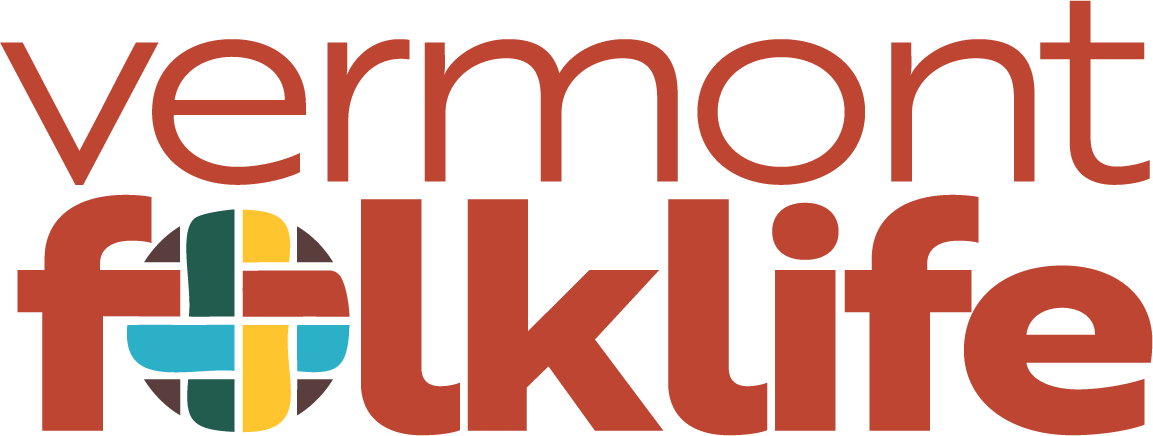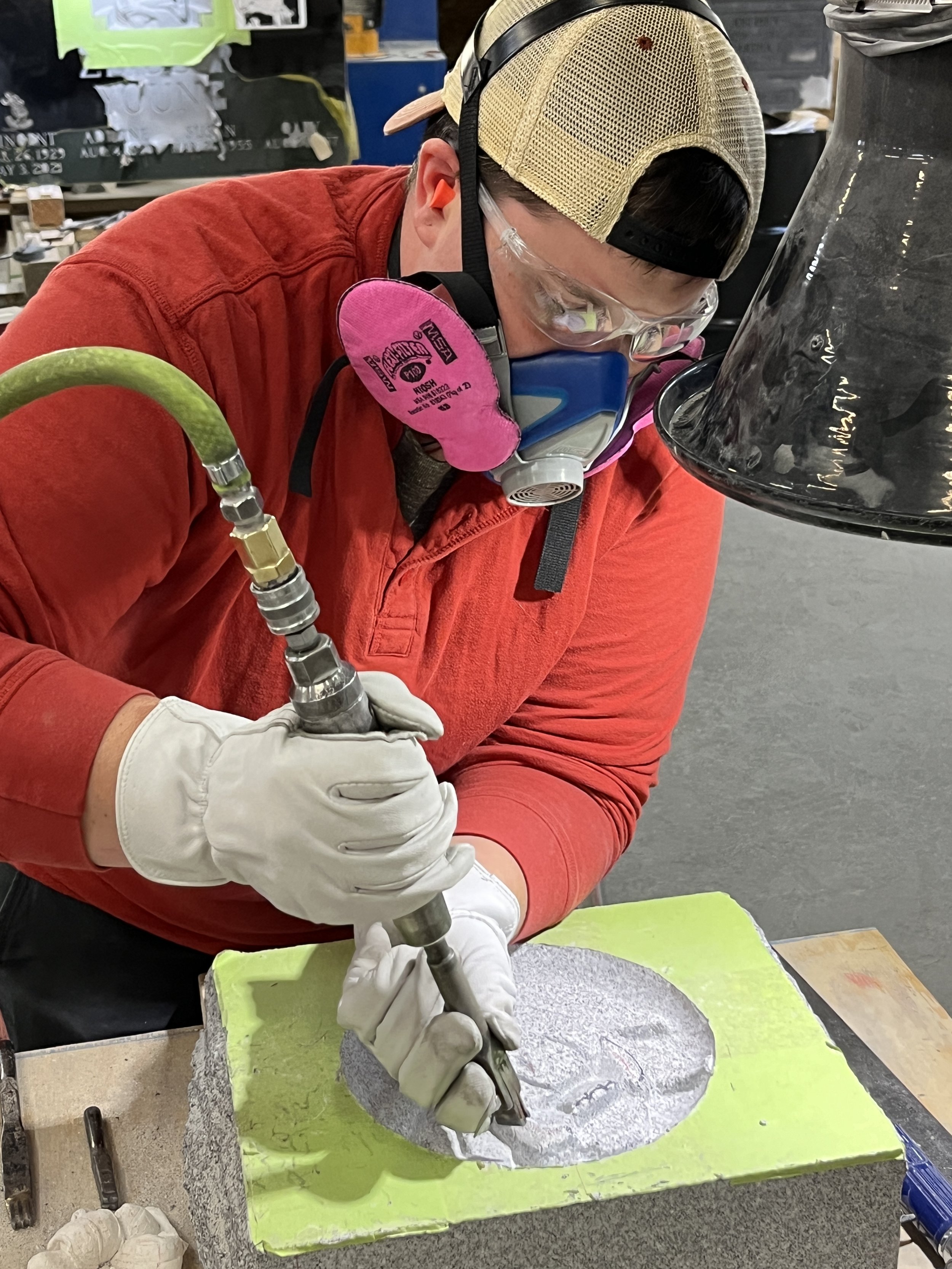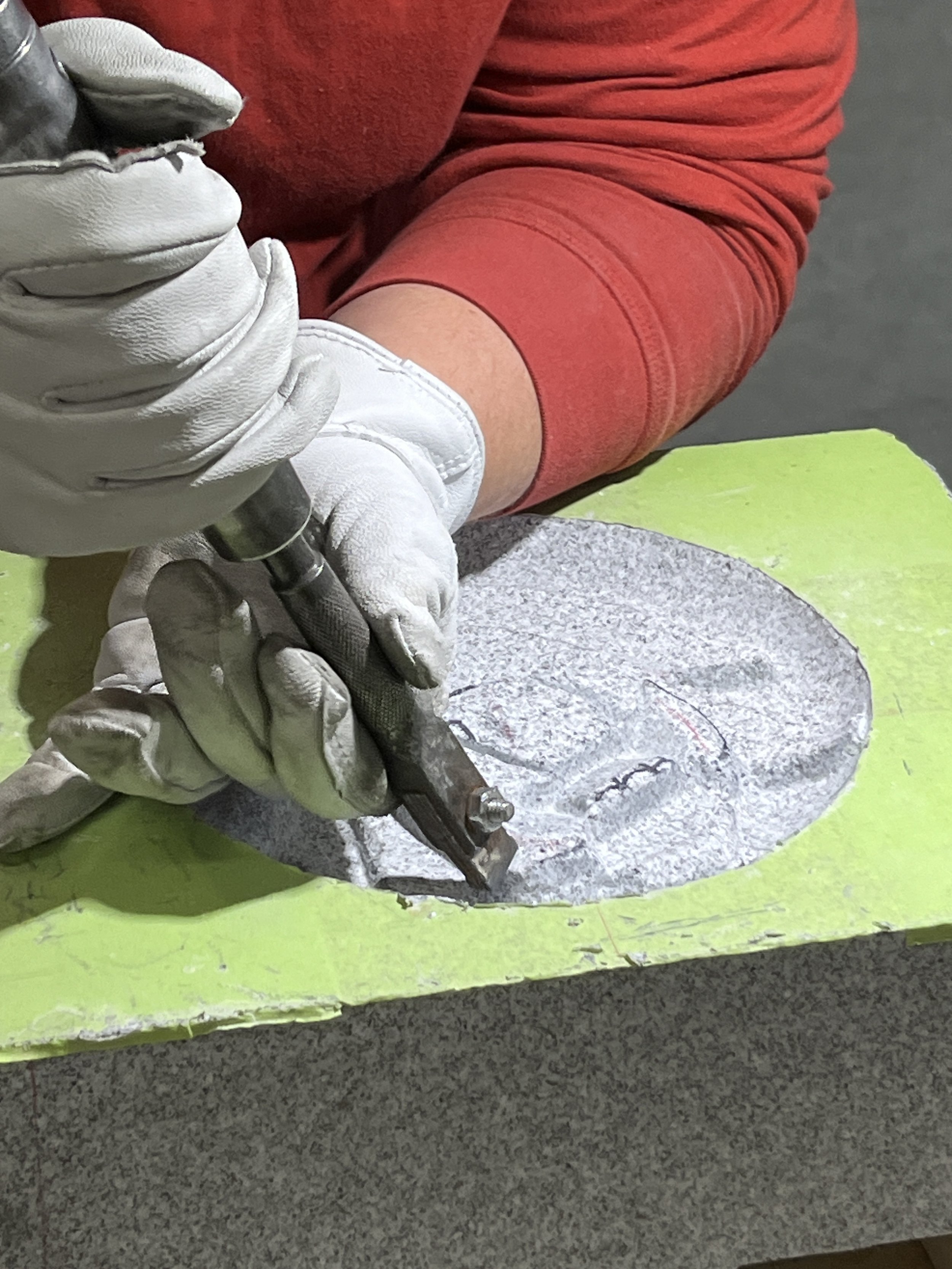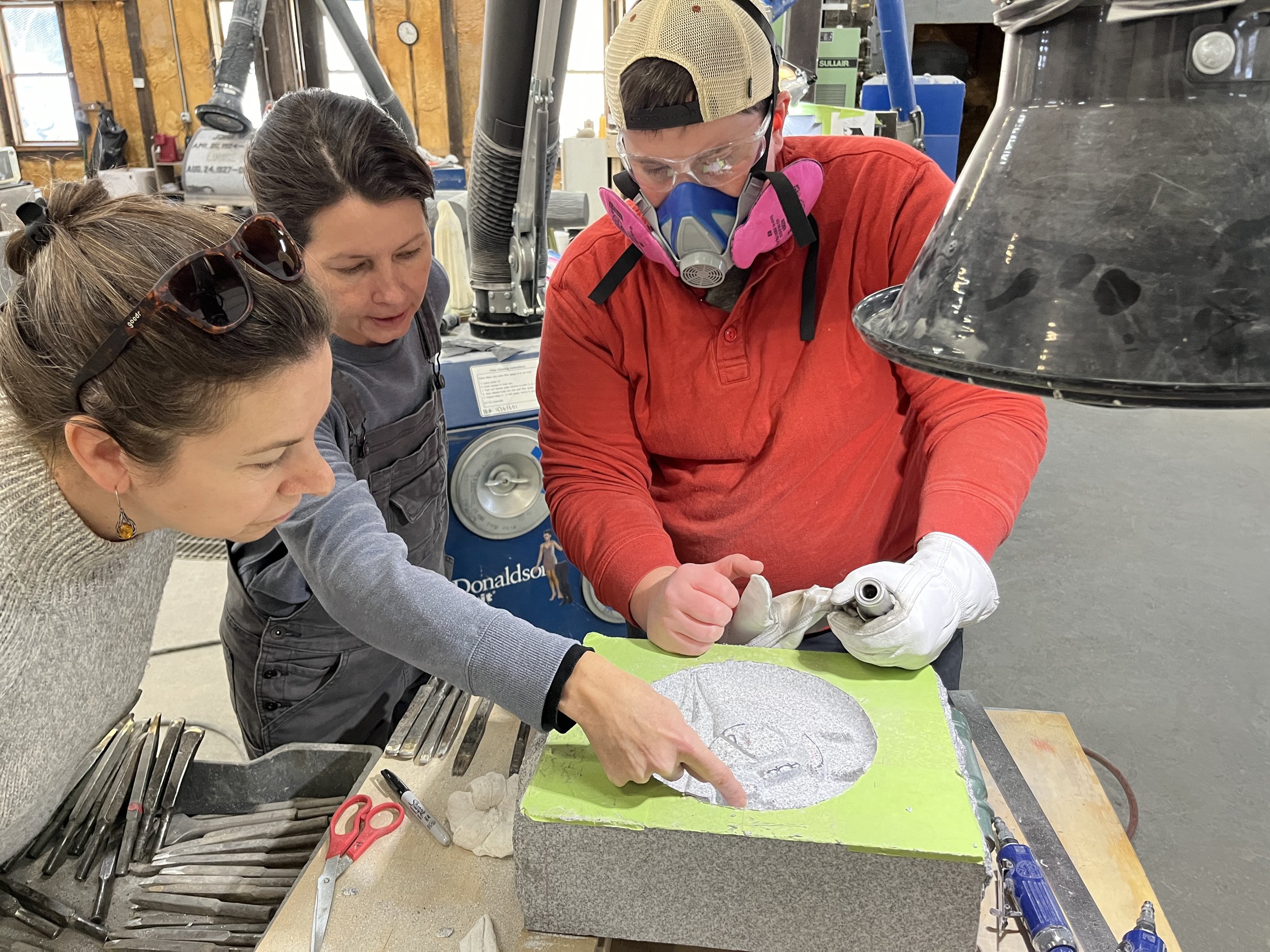Traditional Arts Spotlight: The Long, Slow Burn of Stone Carving
Mentor Artist: Heather Milne Ritchie
Apprentice: Becky Lovely
Traditional Artform: Granite Carving
The 2023-2024 cohort of the Vermont Traditional Arts Apprenticeship Program includes 18 collaborations between mentor artists and apprentices who are working together to keep traditional cultural expressions vital and relevant to the communities that practice them. With funding from the National Endowment for the Arts and a longstanding partnership with the Vermont Arts Council, Vermont Folklife initiated this program in 1992 to support the continued vitality of Vermont's living cultural heritage. In this ongoing series of Field Notes we’ll introduce you to some of this year’s program participants and the traditional art forms they practice. Vermont Folklife has been documenting the work of participants in the Apprenticeship Program since its inception. These interviews and audio-visual records are part of an ongoing collection in our Archive centered around traditional arts, music, and trades.
This note features interview excerpts, audio, and photos recorded at a recent site visit by VT Folklife staffers Mary Wesley and Eliza West.
Watch a video from the site visit.
Mary Wesley: Will you introduce yourself?
Heather Milne Ritchie: I'm Heather Milne Ritchie. I'm a professional granite carver in Barre, Vermont. I was born and raised in Barre and found my way into granite carving through the Vermont Folklife Center Apprenticeship Program when my mentor and teacher, George Kurjanowicz, was looking for a new apprentice and I've stuck with it ever since. I think it's really important to teach people how to do this trade exclusively because there are so few of us in the industry that do this kind of work. There's only a dozen of us carvers, so it's kind of up to us to teach the younger generations, or to teach anyone the trade, because the manufacturers don't see it as their role to be the ones responsible for instruction. So myself and other carvers in the industry have been working for a long time. I would say I've been actively teaching for about ten years and the older generation has been teaching much longer than that and we've all been training people. But it's hard to find people that want to stick with it.
I met Becky through a mutual friend, a granite friend, a very successful and motivated salesman who I've known for over 20 years. Really great guy, and just off of his word saying, "I think this would be a good fit for you" I immediately said, "Give her my number, let's get in touch. I think we can make something happen." So Becky and I initially met over drinks for an hour or two. It was a little while we hung out with my partner and colleague, Sylvain Metivier, who we rent the space with, and my colleague Sophie Bettman-Kerson. So we sat down and kind of got to know each other and decided, "Yeah, we think this could work."
Mary Wesley: Awesome. [Becky], can we hear your side of the story? How was it to meet Heather? How did this idea start and unfold for you?
Becky Lovely: Okay well, first off, my name is Becky Lovely. I grew up in Waitsfield, Vermont. Currently, I'm a dental assistant, so quite a far leap from granite, but actually quite similar when you really break it down to the little aspects of drilling and dust and protective wear and all that jazz. How I got into the interest of granite was kind of just little hints in my everyday life. I hadn't really put much thought into it but one day I heard an ad on the radio for a business that was hiring. And then by happenstance, I was talking to my wife's co-worker's boyfriend who works in a granite shed, so I said, "Hey, D.J., I want to do the really artsy, fun part of the granite, not the big cutting and measuring." The technical stuff isn't necessarily for me, but the pretty stuff, I guess I could call it, was really intriguing to me. I don't really have much of an art background, but I always was really interested in high school. I did a basket weaving course, I did wheel throwing and ceramics, you know, that sort of stuff. But nothing quite like this where you start with this big rock and make it something so intricate and pretty. It's really fascinating to me and Heather has been a fantastic mentor so far. We think pretty similarly, so she goes at my speed and explains things how I would probably try to explain it to somebody else. So it's been really great getting to work with Heather and hearing all the people that she has worked with in the past. She just speaks so highly of everybody. So it's really great to have this relationship that Heather and I are building with.
Mary Wesley: So did you talk about what you would cover over the year? Did you have any goals or visions for what you would want to work on in this space?
Becky Lovely: I think definitely learning the fundamentals, what each tool is, what it's used for, the gist of learning what Heather does right now. I have some little things that I would like to try and do, but as far as what I want to learn, it's just whatever Heather deems necessary for the market right now, what's coming in. Seems like it's a lot of memorial pieces like the Madonna and Jesus and some doves and that sort of thing. So I guess just what's needed first and then building off that to whatever I might like down the road.
Mary Wesley: Can you talk us through a few of the things you've been working on lately?
Becky Lovely: Sure. The first thing that I did, Heather had me using tools pretty much my first day here after talking me through the shop and what she does and the flow, that sort of thing. She had me doing some hand chisel work to shape a piece of granite that she picked out for me. And then we have an 8.5 inch circle on that piece that is my niche. So we're carving a lily in that. Originally Heather found this little plaque and we were going to base my carving off that. It was a few oak leaves and acorns and that sort of thing. But she welcomed me to find my own design if anything came up in the week or two after we started. And my grandmother actually got sick, so I decided to switch gears to do a lily to represent her in that.
Mary Wesley: That's awesome. What are you learning about me working with stone? The material?
Becky Lovely: Yeah. It's simultaneously really soft and really hard. You know, sometimes you have to really dig at something to get it to move. And other times you just touch it and it kind of flies off there. So there's a really interesting finesse to it to get the right amount of pressure and speed and all that to move the stone the way you want it to, which again, is really, really cool to see the way the stone wants to break away versus the way you want it to. So, you know, just learning the stone, learning the techniques, all that.
Click through the images below to see Becky’s progress to date on carving her lily.
Heather Milne Ritchie: I just want to say, I think Becky's doing a fantastic job right out of the gate with this. A lot of people struggle with the physicality of it, and that doesn't seem to be an issue at all with her. Also a lot of the other people that I've taught have come into it with an art background, already identifying as an artist, and she does not. And it's really refreshing to be able to teach someone and break it down in a way that at the core it is about the art, but in the process it's about taking things step by step, and explaining things in a way that anyone could do them.
This is something that kind of gets tossed around a lot in this industry with these memorials is that it is commercial art. Every carver I know I consider to be an artist, but, out in the world most people don't look at us that way. So training someone who doesn't have an art background and isn't hanging on to their own ideals or aesthetics of what...you know, I hate to sound selfish, but she doesn't really...you don't have anything you want to make for yourself specifically. And that makes my job a lot easier because I can train her to do the things that I need to have happen in my studio, or in any other sculpture studio for the memorial industry, that are really specific to this material and to this industry. And Becky's just wonderful. She's very laid back, but also very serious. She's an incredible listener and has followed through every single time I've given direction. I think this is going to be a really successful venture for both of us.
Mary Wesley: Yeah, it's interesting thinking about, um, the...what do you call it? The long, slow burn?
Heather Milne Ritchie: It is. It is exactly that.
Mary Wesley: Both the art, stone carving, but then also teaching someone to stone carve. That's something about an apprenticeship model that I'm interested in because that long, slow way of learning something, one-on-one, face to face is also…
Heather Milne Ritchie: It's a lost art. It is. And I think that in this day and age, with technology and the immediacy of things being available so quickly to you, whether it's on your phone or in the news or... Information is all around us in ways that it has never been before. And this is a very primitive art. It's a completely traditional art. And I always use that "long, slow burn" verbiage because I need people to be prepared for the fact that it takes a long time. It takes a long time to produce something that looks good. It takes a long time to get good enough and adept enough with the tools to be able to control them to produce something. And that's kind of the fight that we're up against, I think socially is just that, you know, everything happens so dang fast. This doesn't happen fast and it's not supposed to happen fast. And it's okay that it's not happening fast. So, you know, patience is key. And being able to see the forest through the trees, you know, it's really about like, taking a step back sometimes and saying, I'm okay with this taking a long time and, you know, celebrating the small victories. Setting little goals for, that's why Becky and I do things on a very broken down level of like, let's just compartmentalize this and take it section by section, and find these three angles and then move on to the next section. We're never going to get the whole thing done all at once. So celebrating the small victories I think is key in finding success with the long process.
Carbide-tipped chisels ready for use in Heather’s Barre granite carving workshop.
Made Here
VT Folklife is working in collaboration with Heather and Becky and other artists participating in the Vermont Traditional Arts Apprenticeship Program to create a three part podcast series titled The Arts That Shape Us, exploring the nuance and complexity of what the traditions "of Vermont" really are.
This project is generously supported through Vermont Public’s “Made Here” fund.













